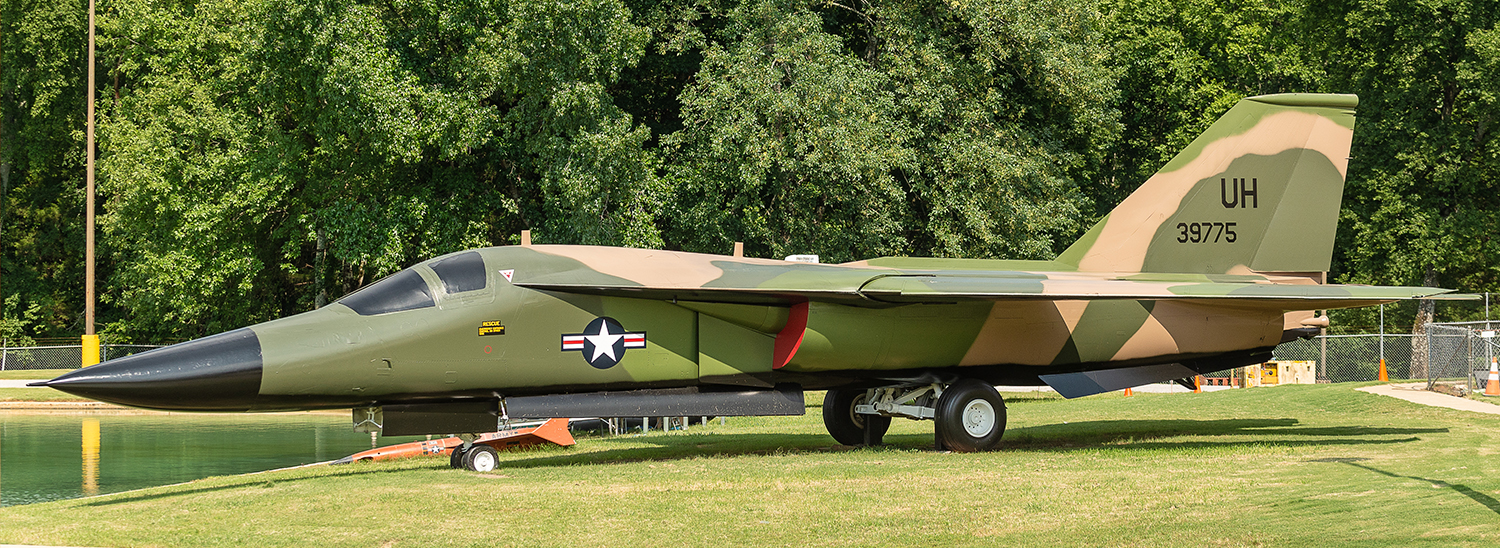
The F-111 was a high speed, all-weather, multi-purpose tactical fighter-bomber that entered the United States Air Force (USAF) inventory in 1967. The aircraft was controversial from its initial development. Originally known as the TFX (Tactical Fighter "X"), the F-111 was conceived by the Department of Defense to meet a USAF requirement for a new supersonic tactical fighter-bomber and the Navy’s need for a new air superiority fighter. The USAF version was known as the F-111A and the Navy version of the F-111B. The first flight of the F-111A took place in December of1964. The Navy's F-111B program was canceled in 1968 because the weight of the design could not be reduced to meet carrier landing requirements. The F-111B’s swing-wing, TF-30 engine, and AWG-9 radar became the basis of the Navy F-14 interceptor.
The F-111 exceeded twice the speed of sound (Mach 2) by sweeping its wings rearward while in flight. The wings were swept forward for takeoffs, landings or slow speed flight. The F-111 was designed for high-speed operations from tree-top level to altitudes above 60,000 feet (18,200 meters). Wing sweep angles ranged from 16 degrees (full forward) to 72.5 degrees (full aft). The two crew members sat side-by-side in a pressurized cockpit module that served as an emergency escape pod and as a survival shelter on land or water. In emergencies, both crew members remained in the cockpit and an explosive charge separated the cockpit module from the aircraft. The module then descended by parachute. Airbags cushioned impact and help keep the module afloat in water. The module could be released at any speed or altitude, even underwater. The aircraft’s wings and much of the fuselage behind the crew module contained fuel tanks. Although the aircraft could be refueled in the air, the plane had a range of more than 2,500 nautical miles (4,000 kilometers) using only internal fuel. External fuel tanks could also be carried on the pylons under the wings and jettisoned if necessary. The F-111 was designed to carry up to 24 conventional as well as nuclear weapons. It could carry up to two bombs in the internal weapons bay while external ordnance included combinations of bombs, guided bombs, and missiles. The loads nearest the fuselage on each side pivoted as the wings swept back, keeping ordnance parallel to the fuselage for reduced drag. The avionics systems included communications, navigation, terrain following, target acquisition and attack, and suppression of enemy air defense systems. The F-111’s automatic terrain-following radar system flew the aircraft at a constant altitude above the ground following the Earth’s contours. It allowed the aircraft to fly in valleys and over mountains, day or night, regardless of weather conditions with a fail-safe automatic climb initiated during any system malfunction. The radar bombing system was synchronized with a laser spotting system for the precise delivery of weapons during night or bad weather. Our F-111 is number 10 of the 18 pre-production aircraft. Although the external appearance of our F-111 is similar to the F-111A, there are some significant differences between this aircraft and the production models. The most striking is the aircrew ejection system. Instead of the cockpit module escape system mentioned above, the pre-production aircraft used a more conventional Escape Pack ejection seat. Among other things, this aircraft participated in testing for runway landings in winter conditions. Over 560 F-111 aircraft were produced in a variety of models, including the F-111A, F-111D, F-111E, and F-111F fighter-bombers; the FB-111A strategic bomber; the F-111C for the Australian Air Force; and an EF-111 electronic warfare version. The versatile "swing-wing" F-111 was officially named the "Aardvark" only at its retirement ceremony on 27 July 1996. The USAF F-111 was replaced by the F-15E and B-1B while the Australian F-111 was replaced in 2010 by the F/A-18 and the F-35. This aircraft is on loan from the National Museum of the United States Air Force.

